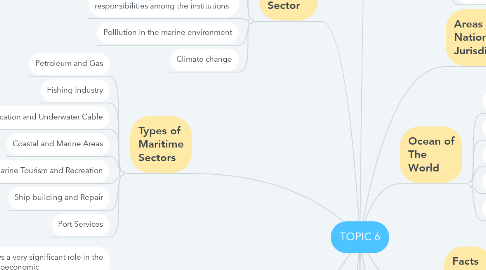
1. Principles Ocean and Coastal Activities
1.1. Navigation and communication
1.1.1. Shipping
1.1.2. Cables construction
1.2. Living marines resources
1.3. Mineral and energy resources
1.4. Tourism and recreation
1.5. Coastal infrastructure and development
1.6. Water disposal and pollution prevention
1.7. Ocean and coastal environment quality protection
1.7.1. marine mammals
1.8. Beach and shoreline management
1.8.1. erosion control programme
1.9. Military activities, naval, enforcement
1.10. Research
1.10.1. Oceanography
1.10.1.1. Geology
1.10.1.1.1. sea floor tectonics
1.10.1.1.2. coastal processes
1.10.1.1.3. sediments
1.10.1.1.4. hydrologic cycle
1.10.1.2. Geography
1.10.1.2.1. wind belts
1.10.1.2.2. weather
1.10.1.2.3. coastal landforms
1.10.1.2.4. world climate
1.10.1.3. Biology
1.10.1.3.1. fisheries
1.10.1.3.2. ecological surveys
1.10.1.3.3. microbiology
1.10.1.3.4. marine adaptations
1.10.1.4. Chemistry
1.10.1.4.1. dissolved components
1.10.1.4.2. tempature dependence
1.10.1.4.3. stratification/density
1.10.1.4.4. chemical tracers
1.10.1.5. Physics
1.10.1.5.1. currents
1.10.1.5.2. waves
1.10.1.5.3. sonar
1.10.1.5.4. thermal properties of water
1.10.1.6. Astronomy
1.10.1.6.1. tidal forces
1.10.1.6.2. oceans on other planets
1.10.1.6.3. origin of water
1.10.1.6.4. origin of life
1.10.2. Marine Science
2. Maritime Industries
2.1. Shipping & related industry
2.2. Fishing industry
2.3. Petroleum and gas industry
2.4. Tourism industry
2.5. Others areas
2.5.1. boat/ship manufacture & repair industry
2.5.2. Food manufacture (sea produce) industry
2.5.3. Marine/land transportation
2.5.4. Sea activities related equipment manufacture industry
2.5.5. Skills training industry (manpower for sea activities/work at sea)
3. Importance of Maritime Industries
3.1. Plays a very significant role in the socioeconomic
3.2. eco-frindly
3.3. Vital for national securoty
3.4. Provide a huge occupational industry for mankind
4. Types of Maritime Sectors
4.1. Petroleum and Gas
4.2. Fishing Industry
4.3. Communication and Underwater Cable
4.4. Coastal and Marine Areas
4.5. Marine Tourism and Recreation
4.6. Ship building and Repair
4.7. Port Services
5. Issues in Martime Sector
5.1. Conflict for usage area as maritime activities stacked to several coastal/offshore areas
5.2. Oil and gas sector is currently affected by the global economy and facing an overcapacity of supply
5.3. Conflict and duplication of powers and responsibilities among the institutions
5.4. Polllution in the marine environment
5.5. Climate change
6. Areas Under National Jurisdiction
6.1. Internal Waters
6.1.1. considered up to 3 nautical miles
6.2. Territorial Waters
6.2.1. up to 12 nautical miles
6.3. Exclusive Economic Zones (EZZ)
6.3.1. up to 200 nautical miles
6.3.2. the coastal state has the right to explore and exploit, and the responsibility to conserve and manage, living and non-living resources within EZZ
7. The Important of The Ocean
7.1. Harbor a tremendous wealth of living and non living things
7.2. Fisheries as source of protein
7.3. Petroleum and gas from sea propel country's growth as energy resources
7.4. A hist for many activities
8. Economic Importance of Living Resources
8.1. Fish
8.1.1. Fisheries resources
8.2. Marine mammals
8.2.1. Ecotourism (whale watching)
8.3. Turtles
8.3.1. Ecotourism (turtle watching)
8.4. Corals
8.4.1. Ecotourism (diving)
8.5. Seaweed
8.5.1. Pharmaceutical and food products
8.5.2. Pharmaceutical and food products
8.6. Algae
9. Economic Importance of Non-Living Resources
9.1. Hydrocarbons (e.g. oil and gas)
9.1.1. Petroleum, methane hydrates
9.2. Polymetallic sulphides
9.2.1. Copper, lead, zinc, silver and gold
9.3. Manganese nodules
9.3.1. Production of steel industry
9.4. Sand and gravel
9.4.1. Construction aggregates (e.g. buildings and highways)
9.5. Phosphorites
9.5.1. Fertilisers and chemical products
9.6. Bromin
9.6.1. Gasoline antiknock compound, fumigants, flame retardant, pharmaceuticals, biocides and pesticides
10. Blue Ecomomy Concept
10.1. Marine Fisheries & Aquaculture
10.2. Oil, Gas & Minerals
10.3. Marine Trade, Shipping & Transport
10.4. Marine Education & Research
10.5. Marine Spatial Planning
10.6. Marine Bio-Technology
10.7. Non-Traditional Species Culture
10.8. Sea Salt Production
10.9. Marine Tourism
10.10. Marine Surveillance
10.11. Marine Renewable Energy
10.12. Carbon Sequestration
11. Ocean of The World
11.1. Arctic Ocean
11.2. Southern Ocean
11.3. Pacific Ocean
11.4. Atlantic Ocean
11.5. Indian Ocean
12. Facts About Ocean
12.1. Interconnecting body of saltwater
12.1.1. made up of several oceans and seas
12.2. 70% of earth surface ; water volume
12.3. Twice the surface of mars and 9x surface of moon
12.4. Contain greatest number of living things
12.4.1. about 178000 of animals

